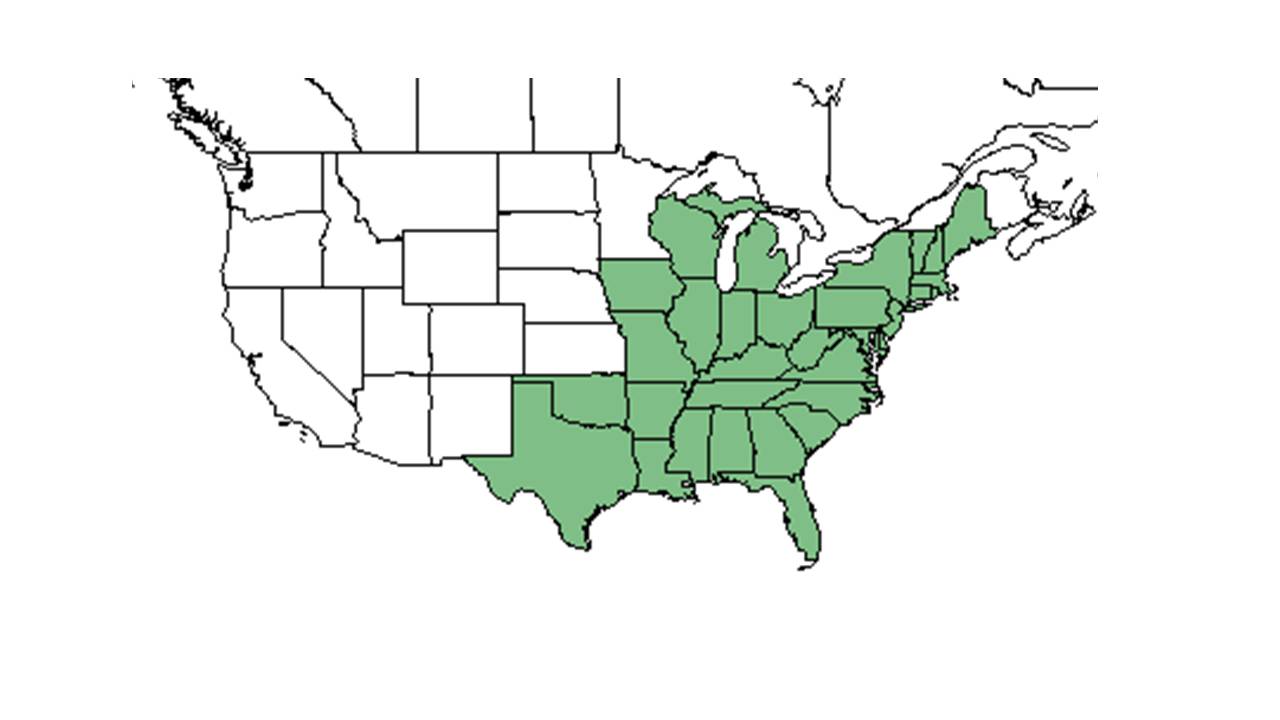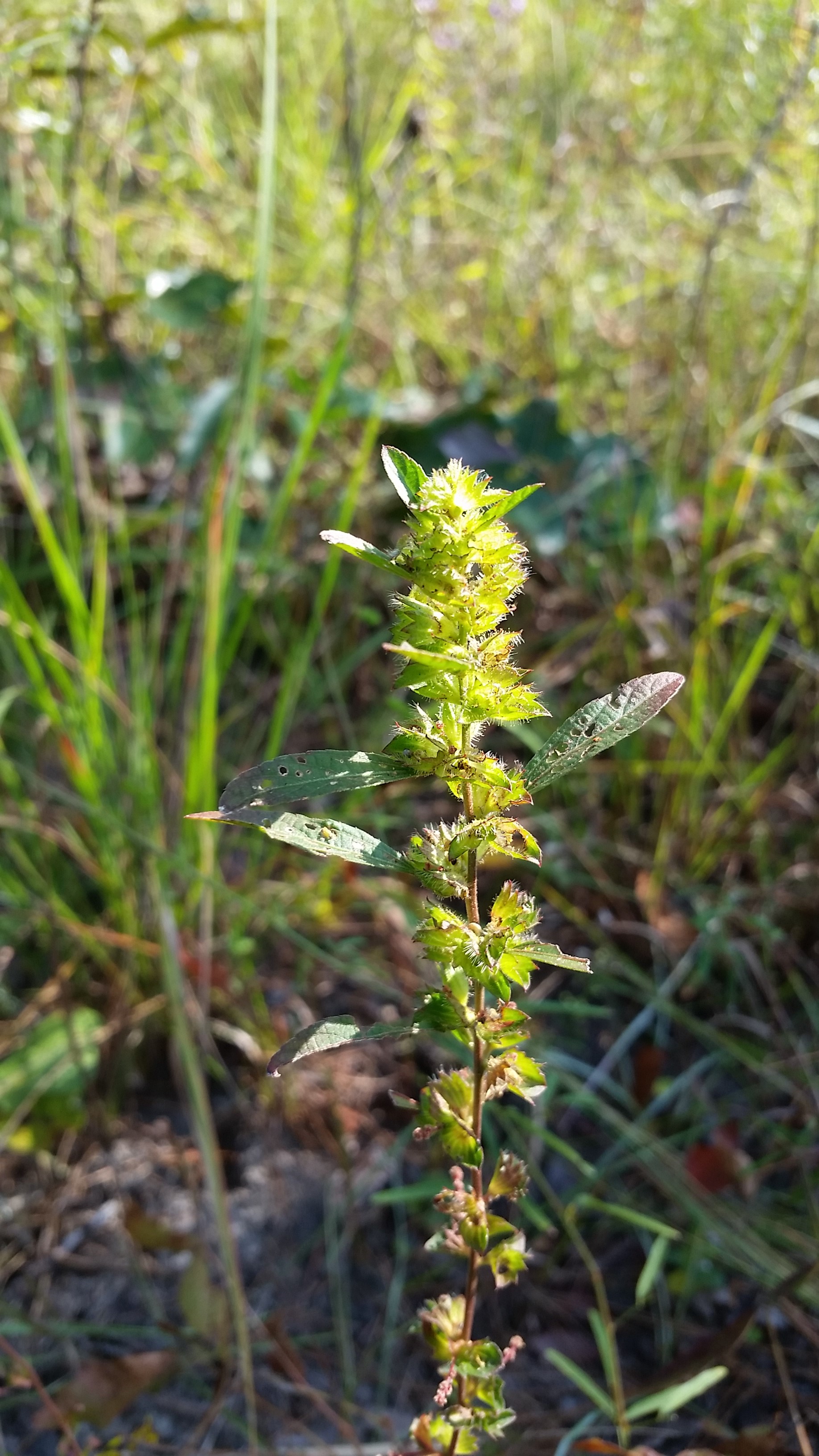Difference between revisions of "Acalypha gracilens"
KatieMccoy (talk | contribs) |
(→Description) |
||
| Line 23: | Line 23: | ||
==Description== | ==Description== | ||
<!-- Basic life history facts such as annual/perrenial, monoecious/dioecious, root morphology, seed type, etc. --> | <!-- Basic life history facts such as annual/perrenial, monoecious/dioecious, root morphology, seed type, etc. --> | ||
| − | + | Annual with hairy stems, the trichomes are incurved. Plant 10-80cm tall. The leaves are elliptic to elliptic-lanceolate, about 2-6cm long, and 0.5-2cm wide. The leaves are obtuse, crenate, base cuneate to rounded, there’s pubescent on both surfaces. Axillary spike with pistillate flowers near the base. Pistillate bracts are often stipitate-glandular, teeth triangular, 5-13. The seeds are reddish to black in color, about 1.2-1.8mm long (Radford 1964). Pistillate flowers basal on inflorescence. Stems with only incurved short trichomes. Petioles 1 cm or less long; teeth of involucral bracts triangular, the longest 2 mm or less. Plant to 0.8 m tall, stems freely branched, densely pubescent with short incurved or appressed ascending trichomes. Leaves elliptic to elliptic-lanceolate, 2-6 cm long, 0.5-2 cm wide, obtuse, crenate, base cuneate to rounded, pubescent on both surfaces, or more or less glabrate; petioles of principal leaves 0.4-1.5 cm long. Axillary spike with 1-5 pistillate flowers near the base, interrupted and continued with a spike of staminate flowers. Pistillate bracts often stipitate-glandular, teeth triangular, 5-13. Seeds reddish to black, 1.2-1.8 mm long. Late June-frost (Radford 1964). | |
| + | |||
| + | Woodlands and disturbed habitats; common throughout piedmont and infrequent in the mountains (Radford 1964). | ||
==Distribution== | ==Distribution== | ||
Revision as of 18:00, 15 December 2015
| Acalypha gracilens A. Gray | |
|---|---|

| |
| Photo was taken by Gil Nelson | |
| Scientific classification | |
| Kingdom: | Plantae |
| Division: | Magnoliophyta - Flowering plants |
| Class: | Magnoliopsida - Dicotyledons |
| Order: | Euphorbiales |
| Family: | Euphorbiaceae |
| Genus: | Acalypha |
| Species: | A. gracilens |
| Binomial name | |
| Acalypha gracilens A. Gray | |

| |
| Natural range of Acalypha gracilens from USDA NRCS Plants Database. | |
Common names: Slender Threeseed Mercury; Three-seeded Mercury; Shortstalk Copperleaf
Contents
Taxonomic notes
Description
Annual with hairy stems, the trichomes are incurved. Plant 10-80cm tall. The leaves are elliptic to elliptic-lanceolate, about 2-6cm long, and 0.5-2cm wide. The leaves are obtuse, crenate, base cuneate to rounded, there’s pubescent on both surfaces. Axillary spike with pistillate flowers near the base. Pistillate bracts are often stipitate-glandular, teeth triangular, 5-13. The seeds are reddish to black in color, about 1.2-1.8mm long (Radford 1964). Pistillate flowers basal on inflorescence. Stems with only incurved short trichomes. Petioles 1 cm or less long; teeth of involucral bracts triangular, the longest 2 mm or less. Plant to 0.8 m tall, stems freely branched, densely pubescent with short incurved or appressed ascending trichomes. Leaves elliptic to elliptic-lanceolate, 2-6 cm long, 0.5-2 cm wide, obtuse, crenate, base cuneate to rounded, pubescent on both surfaces, or more or less glabrate; petioles of principal leaves 0.4-1.5 cm long. Axillary spike with 1-5 pistillate flowers near the base, interrupted and continued with a spike of staminate flowers. Pistillate bracts often stipitate-glandular, teeth triangular, 5-13. Seeds reddish to black, 1.2-1.8 mm long. Late June-frost (Radford 1964).
Woodlands and disturbed habitats; common throughout piedmont and infrequent in the mountains (Radford 1964).
Distribution
It is frequent in north, central, and west Florida. This is also found west to Texas and north to Massachusetts. A. gracilens is also found in Virginia, Georgia, Florida, Alabama, and West Virginia (Radford 1964).
Ecology
Habitat
It can be found frequently burned sandhills (Entisols), pine flatwoods (Spodosols), and upland pine communities (Ultisols), as well as floodplain forest (Alphasols). It thrives in frequently burned pine communities (Heuberger et al. 2003). It occurs in both native communities and areas with very disturbed soil (FSU Herbarium). It occurs in a fairly wide range of well-drained soils, from deep sand to loams (FSU Herbarium). Its light tolerance is fairly broad, from full light to shaded areas on the edges of open areas (FSU Herbarium). Common plant in southeastern U.S. pine communities. It is found in sandhills, flatwoods, hammocks, woodlands and disturbed sites (Radford 1964, Hall 1993, Wunderlin and Hansen 2003). In addition to the Coastal Plain it is common throughout the Piedmont region and infrequent in the mountains (Radford 1964).
Associated species include Liatris gracilis, L. tenuifolia, Polygonella gracilis, Didodia teres, Chrysopis lanuginosa, Rubus cuneifolis, Hypericum gentianoides, Trichostema dichotomum, Eupatorium compositifolium, and others (FSU Herbarium).
Phenology
Flowers spring to fall through most of its range. Flowers all year in south Florida (Hall 1993).
Seed dispersal
Seed bank and germination
Fire ecology
Pollination
Use by animals
Diseases and parasites
Conservation and Management
Cultivation and restoration
Photo Gallery
References and notes
Florida State University Robert K. Godfrey Herbarium database. URL: http://herbarium.bio.fsu.edu. Last accessed: June 2014. Collectors: Loran C. Anderson, Cecil R. Slaughter, R.A. Norris, R.F. Doren, and Robert K. Godfrey. States and Counties: Florida: Calhoun, Gadsden, Leon, Liberty, Wakulla, and St. Johns. Georgia: Thomas.
Hall, David W. Illustrated Plants of Florida and the Coastal Plain: based on the collections of Leland and Lucy Baltzell. 1993. A Maupin House Book. Gainesville. 159. Print.
Heuberger, K. A. and F. E. Putz (2003). "Fire in the suburbs: ecological impacts of prescribed fire in small remnants of longleaf pine (Pinus palustris) sandhill." Restoration Ecology 11: 72-81.
Radford, Albert E., Harry E. Ahles, and C. Ritchie Bell. Manual of the Vascular Flora of the Carolinas. 1964, 1968. The University of North Carolina Press. 664-665. Print.
Wunderlin, Richard P. and Bruce F. Hansen. Guide to the Vascular Plants of Florida. Second edition. 2003. University Press of Florida: Gainesville/Tallahassee/Tampa/Boca Raton/Pensacola/Orlando/Miami/Jacksonville/Ft. Myers. 412-13. Print.
